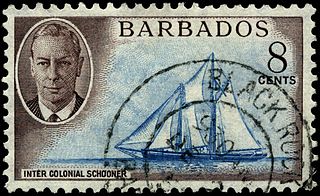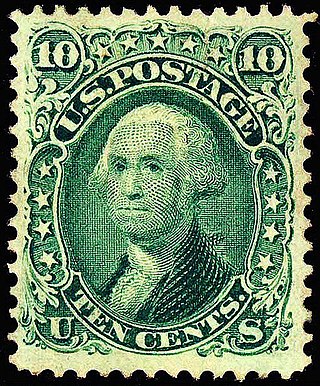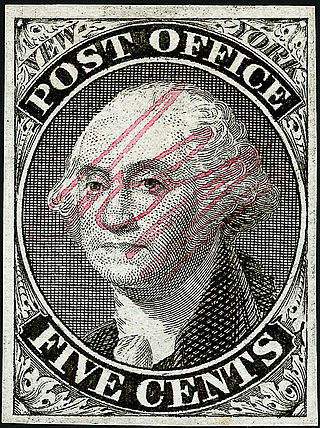Related Research Articles

A postage stamp is a small piece of paper issued by a post office, postal administration, or other authorized vendors to customers who pay postage. Then the stamp is affixed to the face or address-side of any item of mail—an envelope or other postal cover —which they wish to send. The item is then processed by the postal system, where a postmark or cancellation mark—in modern usage indicating date and point of origin of mailing—is applied to the stamp and its left and right sides to prevent its reuse. Next the item is delivered to its address.

Stamp collecting is the collecting of postage stamps and related objects. It is an area of philately, which is the study of stamps. It has been one of the world's most popular hobbies since the late nineteenth century with the rapid growth of the postal service, as a stream of new stamps was produced by countries that sought to advertise their distinctiveness through their stamps.

A postmark is a postal marking made on an envelope, parcel, postcard or the like, indicating the place, date and time that the item was delivered into the care of a postal service, or sometimes indicating where and when received or in transit. Modern postmarks are often applied simultaneously with the cancellation or killer that marks postage stamps as having been used. Sometimes a postmark alone is used to cancel stamps, and the two terms are often used interchangeably. Postmarks may be applied by handstamp or machine, using methods such as rollers or inkjets, while digital postmarks are a recent innovation.

The Penny Black was the world's first adhesive postage stamp used in a public postal system. It was first issued in the United Kingdom on 1 May 1840 but was not valid for use until 6 May. The stamp features a profile of Queen Victoria.

Postal service in the United States began with the delivery of stampless letters whose cost was borne by the receiving person, later encompassed pre-paid letters carried by private mail carriers and provisional post offices, and culminated in a system of universal prepayment that required all letters to bear nationally issued adhesive postage stamps.
This is a partial timeline of significant events in postal history, including dates and events relating to postage stamps.
The Penny Post is any one of several postal systems in which normal letters could be sent for one penny. Five such schemes existed in the United Kingdom while the United States initiated at least three such simple fixed rate postal arrangements.

The Mauritius "Post Office" stamps were issued by the British Colony Mauritius in September 1847, in two denominations: an orange-red one penny (1d) and a deep blue two pence (2d). Their name comes from the wording on the stamps reading "Post Office", which was soon changed in the next issue to "Post Paid". They are among the rarest postage stamps in the world.

Postage stamps and postal history of the Canal Zone is a subject that covers the postal system, postage stamps used and mail sent to and from the Panama Canal Zone from 1904 up until October 1978, after the United States relinquished its authority of the Zone in compliance with the treaty it reached with Panama.

In philatelic terminology a letter sheet, often written lettersheet, is a sheet of paper that can be folded, usually sealed, and mailed without the use of an envelope, or it can also be a similar item of postal stationery issued by a postal authority. Letter sheets derive from the form in which written correspondence was made up before the mid-19th century—letters were written on one or more sheets of paper that were folded and sealed in such a way that the address could be written on the outside.

Plating refers to the reconstruction of a pane or "sheet" of postage stamps printed from a single plate by using individual stamps and overlapping strips and blocks of stamps. Likewise, if a sheet 10 or 20 postal cards is typeset, the variations of the letters or design elements may allow reconstruction or plating of the sheets based on these differences.

This is a survey of the postage stamps and postal history of Barbados.

Presidents of the United States have frequently appeared on U.S. postage stamps since the mid-19th century. The United States Post Office Department released its first two postage stamps in 1847, featuring George Washington on one, and Benjamin Franklin on the other. The advent of presidents on postage stamps has been definitive to U.S. postage stamp design since the first issues were released and set the precedent that U.S. stamp designs would follow for many generations.

The 1930 Graf Zeppelin stamps were a set of three airmail postage stamps, each depicting the image of the Graf Zeppelin, issued by the United States Post Office Department in 1930, exclusively for delivery of mail carried aboard that airship. Although the stamps were valid for postage on mail sent on the Zeppelin Pan American flight from Germany to the United States, via Brazil, the set was marketed to collectors and was largely intended to promote the route. 93.5% of the revenue generated by the sale of these stamps went to the Zeppelin Airship Works in Germany. The Graf Zeppelin stamps were issued as a gesture of goodwill toward Germany. The three stamps were used briefly and then withdrawn from sale. The remainder of the stock was destroyed by the Post Office Department. Due to the high cost of the stamps during the Great Depression, most collectors and the general public could not afford them. Consequently, only about 227,000 of the stamps were sold, just 7% of the total printed, making them relatively scarce and prized by collectors.
The London Penny Post was a premier postal system whose function was to deliver mail within London and its immediate suburbs for the modest sum of one penny. The Penny Post was established in 1680 by William Dockwra and his business partner, Robert Murray. Dockwra was a merchant and a member of the Armourer and Brasiers Livery Company and was appointed a Customs Under-Searcher for the Port of London in 1663. Murray would later become clerk in the excise office of the Penny Post. The London Penny Post mail service was launched with weeks of publicity preceding it on 27 March 1680. The new London Penny Post provided the city of London with a much needed intra-city mail delivery system. The new Penny Post was influential in establishing a model system and pattern for the various Provincial English Penny Posts in the years that followed. It was the first postal system to use hand-stamps to postmark the mail to indicate the place and time of the mailing and that its postage had been prepaid. The success of the Penny Post would also threaten the interests of the Duke of York who profited directly from the existing general post office. It also compromised the business interests of porters and private couriers. The Penny Post was also involved in publishing various criticisms towards the British monarchy, the Duke of York in particular, which ultimately led to the takeover of the Penny Post by crown authorities. The earliest known Penny Post postmark is dated 13 December 1680 and is considered by some to be the world's first postage 'stamp'.

The New York Postmaster's Provisional is, as its designation implies, a postage stamp provided by the New York Post Office to facilitate the prepayment of mail at a time when the United States had not yet issued postage stamps for national use. Placed on sale on July 14, 1845, this was the nation's first provisional stamp to be issued by a local post office in response to the congressional postal reform act that had taken effect two weeks earlier. That law, passed on March 3, 1845, standardized nationwide mail rates, with the result that the use of stamps became a practical and reliable method of postal prepayment. Before standardization, the many different postal rates in different jurisdictions had made fees too unpredictable to prepay all letters with stamps as a matter of course, with the result that recipients of letters—rather than senders—generally paid the postage on them. Baltimore announced the issue of a provisional stamp one day after New York, on July 15, and New Haven soon followed. The New York issue has been cited as "the most elegantly executed and widely used of the group of provisionals issued by eleven different [U. S. post] offices between 1845 and 1847."
Puerto Rico topics have been featured on the stamps of Spain and of the United States. Spanish stamps are found at Postage stamps and postal history of Puerto Rico.

Territories of the United States on stamps discusses commemorative postal issues devoted to lands that have been ceded to the nation or purchased by treaty in conjunction with both war and peace. Thirteen states have been created from colonial territories, two from independent republics, four from previous states in the Union, and an additional thirty-one from United States territories.

The history of Virginia through the colonial period on into contemporary times has been depicted and commemorated on postage stamps accounting for many important personalities, places and events involving the nation's history. Themes are particularly rich in early American and new nation history, historical landmarks, and Virginia-born presidents.

Canada 12d black or The Black Empress of Canada is the rarest Canadian postage stamp, issued in 1851. The 12-pence stamp shows the portrait of Queen Victoria and is the third stamp issued by the province.
References
- ↑ "The Beginning of Adhesive Postage in the United States" (PDF). Archived from the original (PDF) on 2011-10-03.